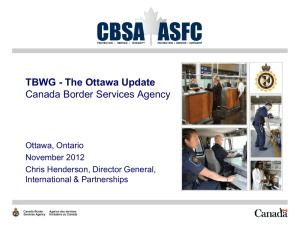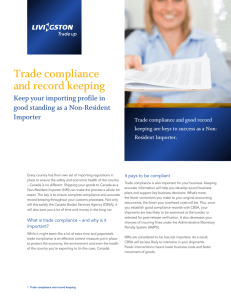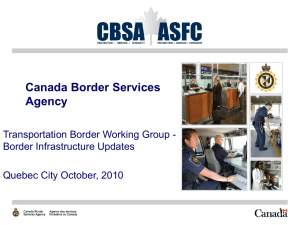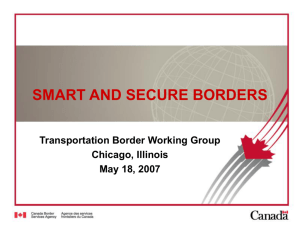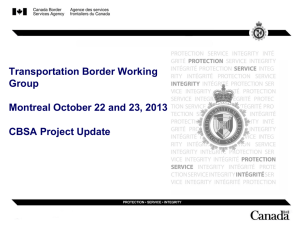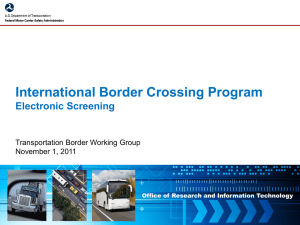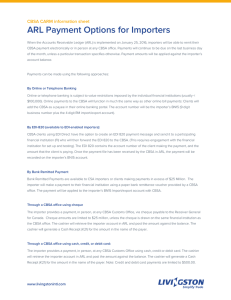CBSA Update - Dan Lagacé, Canada Border Services Agency
advertisement
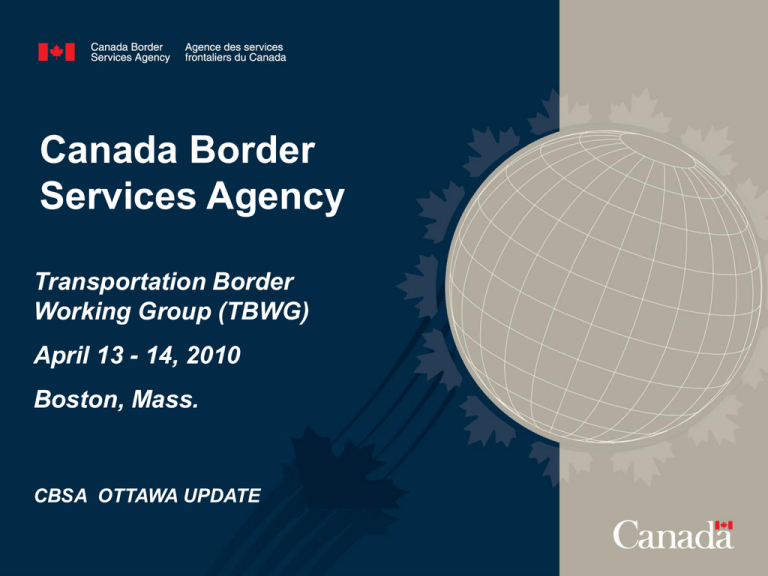
Canada Border Services Agency Transportation Border Working Group (TBWG) April 13 - 14, 2010 Boston, Mass. CBSA OTTAWA UPDATE Border management is based on three key pillars: • the early collection and assessment of information • shared intelligence • mitigating risk while minimizing impact on legitimate trade and travel. 2 Partners in Protection (PIP) and Customs-Trade Partnership Against Terrorism • In June 2008, Canada and the U.S. officially recognized compatibility between each other’s cargo security programs – the U.S. Customs-Trade Partnership Against Terrorism Program (C-TPAT) and Canada’s Partners in Protection Program (PIP). • The CBSA and CBP are in the process of examining how to align their systems, policies and procedures in a way that respects each other’s heritage, culture and legislation. The goal is to harmonize by the end of 2010. 3 eManifest • eManifest will change the commercial import process to incorporate the CBSA's integrated risk management approach and to keep pace with the changing global environment. • In June 2009, amendments were made to the Customs Act in support of the Government of Canada's strategy to strengthen security and facilitate trade. These amendments will provide the required legislative foundation for eManifest, the third phase of the Advance Commercial Information program. 4 Harmonized Risk Scoring and Advance Trade Data (HRS-ATD) • In March 2009, HRS-ATD delivered phase 1 of its scoring enhancements; an improved risk scoring algorithm for our automated risk assessment system. • The new scoring enhancements improve the ability of the Marine Container Targeting Units and the National Risk Assessment Centre (NRAC) to assess marine cargo prior to its arrival in Canada. 5 Border Enforcement Security Task Force (BEST) • CBSA’s membership in the three BEST teams (Niagara, Windsor and Pacific regions) began the week of January 11th. • A review of CBSA’s participation and resulting effects is planned for November 2010. 6 Joint Border Threat and Risk Assessment (JBTRA) • A Canadian Interdepartmental Working Group was assembled to asses border security. Co-chaired by the CBSA and the Royal Canadian Mounted Police (RCMP), the Interdepartmental Working Group includes key border security stakeholders. • When completed, the Joint Border Threat and Risk Assessment (JBTRA) will provide policymakers, resource planners, and law enforcement officials a comprehensive strategic assessment of threats and risks to national security, criminal enterprises, migration, agriculture and health to the U.S.-Canada border at and between the Ports of Entry (PoE). 7 Cross-Border Currency Enforcement Information-Sharing Memorandum of Understanding with the United States • money laundering is a serious issue involving billions of dollars annually and contributes to significant economic losses and violence. • A Memorandum of Understanding (MOU) on the Exchange of Currency Seizure Information between the CBSA, United States Immigration and Customs Enforcement (U.S. ICE) and U.S. CBP has been prepared and is awaiting signature. 8 Questions? ______ Daniel Lagacé Canada Border Services Agency (613) 952-8529 9
